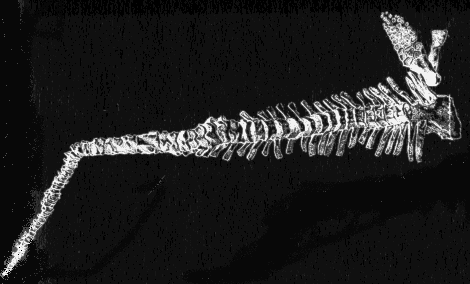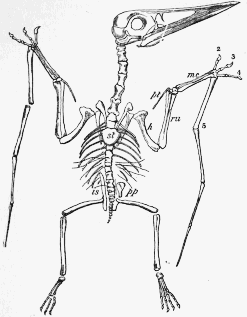Mary Anning
Today, the forgotten "Young Mozart" of paleontology. The University of Houston's College of Engineering presents this series about the machines that make our civilization run, and the people whose ingenuity created them.
In 1800 a lightning bolt struck little Mary Anning. She was 15 months old. The three older girls taking care of her all died; but Mary's parents managed to revive her. Of course, as Mary Anning's fame spread, so did that story.
Mary's father was a cabinetmaker in Lyme Regis on the south Coast of England. He would take her out on the cliffs to look at the "curiosities" embedded in the stone. Those curiosities were, in fact, a rich lode of fossil remains.
When Mary was eleven, her father died of tuberculosis. That would've been a tough enough loss for Mary, but it also meant financial hardship. Then she chanced to sell one of her fossils. Suddenly she saw she could supplement the family income.
Soon after, she found what looked like a four-foot alligator skull in the cliff. She got it out with her brother's help, but she knew there had to be more. For months she looked for the rest of the monster.
Finally, one night, a terrible storm placer-mined the coastal cliffs and exposed enough of the skeleton so that Mary, now 12, could begin excavation. She hired local workmen and oversaw the careful extraction of the fossil. She'd given us the first whole ichthyosaurus skeleton.
For the next 36 years Anning unearthed the fossils of Lyme Regis. The timing was right. Scientists were just learning that geological history reached back far beyond the Biblical begats. The presidents of the Geological Society became her close friends. One even arranged some government funding for her work.
She made her second major find when she was 22. It was the first whole skeleton of a plesiosaurus, located in the tidewater. That one took Anning years to get out. It also secured her international fame -- at least for a while.
At 28 she found the first pterodactyl skeleton. Stephen Jay Gould tells how her "keen insight and uncanny field work" were driving 19th-century biologists crazy -- how they tried to explain all those mad beasts -- part fish, part bird, part lizard.
Mary Anning died of breast cancer in 1847, just as Darwin was writing Origin of Species but hesitating to publish it. After Anning's death, 19th-century scientists simply wrote her out of their books. The naturalists who'd bought her specimens were credited with their discovery. It didn't occur to them to credit a woman from the lower classes with such astonishing work.
So an uneducated little girl, with a quick mind and an accurate eye, played a key role in setting the course of the 19th-century geologic revolution. Then -- we simply forgot about her.
I'm John Lienhard, at the University of Houston, where we're interested in the way inventive minds work.
(Theme music)
Cole, S., The Dragon in the Cliff. New York: Lothrop, Lee, & Shepard Books, 1991. (This is a fictionalized book for young people solidly based on the historical record.)
Gordon, Mrs., The Life and Correspondence of William Buckland. London: John Murray, Albermarle Street, 1894.
Fradin, D.B., Remarkable Children. Boston: Little, Brown and Company, 1987. (This is another young person's book.)
See also the listing under "Anning, Mary" in the Dictionary of National Biography and a fleeting but important reference to Mary Anning in Gould. S.J., Eight Little Piggies: Reflections in Natural History. New York: W.W. Norton & Company, 1993, p. 86 et seq.; and in Alic, M., Hypatia's Heritage, Boston: Beacon Press, 1986, p. 115.
After Mary Anning's death, the story was spread that her brother and not she had found the original ichthyosaurus skull. One momentary acknowledgment for her work came from her longtime friend Henry de la Beche, a president of the Geological Society. He wrote the Society's first obituary for a non-member. Sheila Cole quotes much of it. De la Beche said, in part:
I cannot close this notice of our losses by death without adverting to that of one, who though not placed among even the easier classes of society, but who had to earn her daily bread by her labor, yet contributed by her talents and untiring researches in no small degree to our knowledge of the great Enaliosaurians, and other forms of organic life entombed in the vicinity of Lyme Regis. Mary Anning ...
... there are those among us in this room who know well how to appreciate the skill she employed (from her knowledge of the various works as they appeared on the subject) in developing the remains of the many fine skeletons of Ichtyosauri and Plesiosauri, which without her care would never have been presented to comparative anatomists in [uninjured form].
... she bore with fortitude the progress of a cancer on her breast, until she finally sank beneath its ravages on the 9th of March, 1847.
These are troublesome words, for they are spoken in obvious respect and affection. Yet, at the same time, they begin the process of subordination that soon hid this astonishing observational scientist from 20th-century view.
I thank Margaret Culbertson, UH Art and Architecture Library, for the reference work that located most of my modern source material. I thank Heather Moore, UH Special Collections, for her far less successful searches among the older sources -- searches that only revealed the extent to which Anning had been disidentified with her finds in the near wake of her death.

Image by John Lienhard, after one in the American Museum of Natural History
The tail of an ichthyosaurus

From the 1897 Encyclopaedia Britannica
A plesiosaurus drawn by Owen

From the 1897 Encyclopaedia Britannica
Pterodactyl skeleton